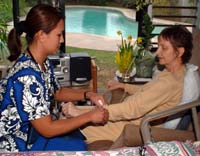- Withdrawal from the External World
- Vision-like experiences
- Loss of Appetite
- Change in Bowel and Bladder Functions
- Confusion, Restlessness, and Agitation
- Changes in Breathing, Congestion in Lungs or Throat
- Change in Skin Temperature and Color
- Hospice Death
- Saying Goodbye
- Being Present at the Moment of Death
The Last Stages of Life
The last stages of life can be very stressful for the dying person and those caring for him/her. You will observe changes that may be upsetting and unfamiliar. Learning about the dying process will help. Many physical changes occur during the process of dying that affect the emotional, social, and spiritual aspects of a person’s life.
There are some signs and symptoms of dying that are observable, although not everyone follows a predictable sequence of events or stages.
Health professionals speak of “dying trajectories” that suggest how persons with specific diseases will die. For example, those with a terminal illness, such as advanced cancer, will show a steady decline toward death. Those with serious chronic illnesses may have peaks and valleys that sometimes give the impression of recovery.
Remember that each person’s death is unique.
It is helpful to understand the common symptoms experienced in people who are dying. You may observe none, some, or all of these symptoms in the dying erson’s last days and hours on earth. You will also learn things to do that can help ease physical pain and suffering.
Withdrawal from the External World

As the end of life approaches, there is a feeling of detachment from the physical world and a loss of interest in things formerly found pleasurable. There is a tendency to sleep more. There is less desire to talk. This is the beginning of letting go of life and preparing for death.
Days or hours before death, the dying person becomes less and less responsive to voice and touch and may not awaken. Sometimes, quite unexpectedly, the person may appear well and even look as if he/she is going to recover.
The person may be alert and talkative. This does not mean that there will be recovery; the person is still dying. Use this as a “window of opportunity” to say what you need to say and have closure.
What you can do:
- Always speak gently, and identify yourself before speaking.
- Use gentle touch and provide reassurance.
- Dying requires energy and focus. Try not to distract the dying person from this necessary preparation. Allow time for silence.
- Remember that you are supporting the person to “let go.”
Vision-like experiences
People nearing death may report encounters with people who are already deceased or describe having been places or seen things not visible to others. These experiences, often referred to as visions or hallucinations, are not typically a drug reaction or mental illness. It is a common symptom of the end-of-life process, and may even provide comfort, reassurance, or a sense of connection to the spiritual realm. The dying may turn their focus to “another world” and talk to people or see things that others do not see. This can be unsettling, and loved ones may not know how to respond.
What you can do:
- Do not judge, explain away or discount this experience. Be as supportive as possible and approach them with empathy, openness, and respect.
- Refrain from discounting the experience and orienting the dying person to “reality.” This is their reality. Most often, these “visions” are reassuring, and they comfort the dying. Rarely do they upset the dying person.
- It is important to differentiate visions from hallucinations or “bad dreams” that may be caused by medications or metabolic changes. While visions of loved ones are generally comforting, “bad dreams” may frighten the dying person. Alert the doctor or nurse about “bad dreams.” An adjustment in medication may correct this.
Loss of Appetite

As death nears, the dying person may lose interest in food and drink. The ability to swallow becomes impaired. Loss of appetite and reduced intake are normal parts of dying. In the early stages of dying, the dying person may prefer only soft foods and liquids.
In the very last stages of life, however, they may not want any food or drink. A dying person may want to suck on ice chips or take a small amount of liquid, just to wet and freshen the mouth, which can become very dry. In the last stages of dying, forcing food when the body says “no” may be harmful or painful to the dying person. Many dying persons will exhibit the “clenched jaw” sign as a way of saying “no.” Forcing fluid may cause choking, or the dying person may draw liquid into the lungs, making matters worse.
It is hard for most people to respect the dying person’s lack of appetite. That’s because many of us equate food
with caring. Family members may feel that withholding nutrition is cruel or neglectful. They may worry that they
are “killing” their loved one.
It is important to remember that as the physical body is dying, the vital organs are shutting down, and nourishment is no longer required to keep them functioning. This is the wisdom of dying, and the body knows exactly what to do.
What you can do:
- Refrain from giving liquids or food unless requested.
- Wet the lips and mouth with a small amount of
- water, ice chips, or a sponge-tipped applicator
- dipped in water.
- Protect lips from dryness with a protective lip balm.
- Continue to be a caring and loving presence.
so I am not alone, so you are not alone.
–Yannis Ritsos
Change in Bowel and Bladder Functions
The two major concerns are constipation and incontinence (loss of control over bowel and bladder functions). Constipation may be caused by lack of mobility, pain medication, and decreased fluid intake. If left untreated, fecal impaction may occur and can become uncomfortable. Laxatives are generally needed to keep the bowels clean.
Incontinence, or loss of bowel/bladder control, is likely to be distressing to the dying person and those in attendance. In the early stages, “accidents” can occur. As death nears, the muscles in these areas relax further and contents are released. This is normal. Urine is highly concentrated and sparse and may look tea-colored.
Sometimes a urinary catheter is inserted, or the dying person may wear “diapers” or briefs. This will help keep linen clean (changing linen may be more disturbing to the dying person than the catheter or the diapers).
What you can do:
- Keep affected areas clean and dry to avoid rashes or bedsores.
- Watch for signs of constipation and incontinence, and help loved ones report this to the physician or nurse.
- Talk to the doctor or nurse about the advantages of reducing food and fluid in the last stages of dying.
Confusion, Restlessness, and Agitation

Restlessness and agitation are common. These symptoms may be caused by reduced oxygen to the brain, metabolic changes, dehydration, and pain medications.
“Terminal delirium” is a condition that may be seen when the person is very close to death, marked by extreme restlessness and agitation. Although it may look distressing, this condition is not considered to be painful.
There are medications available to control symptoms. Be aware there may be unfinished business. Dying persons may try to hold on until they feel a sense of security and completion. Picking, pulling, and fidgeting behaviors may also be seen. This can result from medications, metabolic changes, or decreased oxygen to the brain.
What you can do:
- Never startle the dying with bright lights, harsh tones, or abrupt movement.
- Always identify yourself. Even if the dying person
- knows you well, he/she might not recognize you at
- this time.
- Use a gentle voice and reassuring touch.
- With mindful awareness, be sensitive to any cues that might signal that there is something the person wants to resolve before he/she can let go. Offer support.
- Consider the use of light massage and soothing music.
- Ask the doctor if there are any medications that might help relieve the agitation.
Changes in Breathing, Congestion in Lungs or Throat
You may observe that breathing is shallow and quickened, or slow and labored. The person may make gurgling sounds, sometimes referred to as the “death rattle.” These sounds are due to the pooling of secretions and an inability to cough them up. The air passing through the mucus causes this sound.
The breathing pattern most disturbing to witnesses, called Cheyne-Stokes breathing, is marked by periods of no breathing at all (up to 45 seconds), followed by deeper and more frequent respirations. These respirations are common and result from decreased oxygen supply to the vital organs and a build-up of waste products in the body.
This condition is not uncomfortable or painful for the dying person, although it may be unsettling to observe. The “death rattle” or Cheyne-Stokes breathing indicate that death is near.
What you can do:
- Do not panic. This can increase any fear that may already be present for the dying person.
- Raise the head of the bed (mechanically or with pillows) to help breathing.
- If secretions are pooling in the mouth, turn the head and position the body so that gravity can drain them. Suctioning rarely helps and is not recommended.
- If appropriate, wipe out the mouth with a soft, moist cloth to cleanse excess secretions.
- Speak gently and lovingly, and use gentle reassuring
- touch to ease fear.
- Alert the doctor or nurse if breathing is especially labored or if you notice the “death rattle” and Cheyne-Stokes breathing.
Change in Skin Temperature and Color
As the body dies, the blood moves away from the extremities toward the vital organs. You may notice that while the extremities are cool, the abdomen is warm. You may notice changes in body temperature.
The dying person may feel hot one minute and cold the next. As death approaches, there may be high fever. You also may see purplish-bluish blotches and mottling on the legs, arms or on the underside of the body where blood may be collecting. As death nears, the body may appear yellowish or waxen in color.
What you can do:
- Try to keep the person as comfortable as possible.
- Use a damp, cool washcloth to cool a person who feels too hot (be alert to signs such as kicking off the blankets).
- Cover the dying person with a blanket if he/she feels too cold. Don’t use electric blankets or heating pads, as these may burn the skin.
- Alert the doctor or nurse if you notice changes in skin color. This may be a sign that death is near.
- Using a fan to circulate air may make the person more comfortable.
Tips for Caregivers

You can be a caring presence throughout the dying process. Your presence for the dying person and his/her loved ones indicates loving kindness, compassion, and
willingness to provide practical help.
Learn. Learn what you can about the dying person’s illness and the dying process so you can provide comfort and assurance.
Realize your limitations. No one is perfect. No one can do everything. Get help when you need it. Take a break when you need one. Encourage the dying person and his/her loved ones to call the doctor or nurse with questions.
Managing Physical Pain
Most physical pain can be controlled. No one should die in pain when the means to relieve it are available. All persons have the right to have their pain controlled.
Pain is real. Always believe a person who says he/she has pain. Remember that each person is an individual and perceptions of pain differ.
Talking to the doctor. People should expect their doctors and nurses to ask these questions about pain:
- Do you have pain?
- Where is it? What does it feel like: dull, stabbing, throbbing, etc.?
- How intense is the pain? Please rate it on a scale from 0 to 10, with 10 being the worst pain you’ve ever had.
- What makes the pain better or worse? The answers to these questions will help the doctor prescribe the right medicine in the right amount. Before the conversation is over, make sure that the dying person and his/her caregivers understand:
- What may be causing the pain
- The recommended treatment
- The possible side effects
- What to do if there are questions or concerns
It is a committed, thoughtful decision.
– M. Scott Peck
Hospice Death

Hospice care can be given in the home, nursing home, hospital, or residential facility. There are 7 hospice programs in Hawaii. Hospice care is available on every island except Niihau and Lanai. On Oahu, there are 3 dedicated hospice facilities, two affiliated with St. Francis Hospice (The Sister Maureen Kelleher Center and the Maurice J. Sullivan Family Hospice Center), and the Hospice Hawaii Kailua home. Several hospitals across the state work with local hospices to provide hospice carein the hospital. In the hospice philosophy, death is held as a natural event, not a medical event. “Care” not “cure” is the goal.
When hospice is provided in the home, family members become the primary caregivers. When possible, at least two family members or loved ones should share the responsibilities of caregiving. Hospice staff visit the home on a regular schedule. They are on-call (available round-the-clock) to provide support to the entire family. The hospice interdisciplinary staff includes doctors, registered nurses, social workers, chaplains, home health aides, and volunteers so that the dying may receive holistic, comprehensive care. Hospice nurses and doctors specialize in easing pain and suffering.
Physical and occupational therapists also can assist patients to be as mobile and self-sufficient as possible.
Music therapy, art therapy, counseling, and other therapies are also available. Hospice believes that emotional and spiritual pain are just as real. Counselors, including clergy, are available to assist family members as well as patients.
which means that you really love.
– J. Krishnamurti
Saying Goodbye
Persons who are dying often want “permission to die” from those they love. Often, they want to be assured of five things:
- Things they were once responsible for will be taken care of.
- The survivors will survive without them.
- All is forgiven.
- Their life had meaning.
- They will be remembered.

Saying good-bye is not easy. Yet, it is important for the dying person and his/her loved ones to do so. Take advantage of opportunities when the person is awake and communicative to facilitate the “saying good-bye” process.
If the dying person is not lucid, or in a coma, remember that hearing is the last sense to leave. Assume everything you say can be heard and understood, even if the person is not responsive. Never speak about the dying person as if he/she was not in the room.
Some people feel comfortable lying in bed next to their
loved one as they say their parting words. Others may want to simply hold hands. If music, chanting, or prayer is used to assist the dying, let it be comforting and familiar,
making way for gentle passage. The dying person’s
b ody language will let you know if these sounds are welcome and soothing.
Even with all the preparation and knowledge that death is coming, the moment of death is not easy to see. Even those people who are closest to the dying person may choose to be absent. The decision to be present at the moment of death depends on many things. Do not judge others if they choose not to be present at the moment of death.
Being Present at the Moment of Death
It is not uncommon for the dying person to wait to die until loved ones have left the room. Make sure you allow for this. Sometimes, if a person seems to be holding on, you may simply say, “I’m going to leave the room for awhile. I love you.”
In some cultures, specific prayers, sutras, or other rituals, may ease the passage to death. These may be comforting both to the dying person and to his/her family. Ask your clergy person for assistance.
Now do heart work on the pictures within you.
–Rainer Maria Rilke
Learn more about End-of-life Experiences with Dr. Christopher Kerr, including an excellent TedX Talk https://www.drchristopherkerr.com/tools
